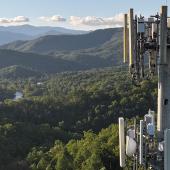This blog is a repost from IWCE’s Urgent Communications, originally published on January 18, 2023.
This blog post is part of the "Tech Talk" series focused on the First Responder Network Authority’s (FirstNet Authority) standards development activities to support public safety. This post recaps discussions linked to public safety and other related topics from the Third Generation Partnership Project (3GPP) Plenary meetings that were conducted in December 2022. The FirstNet Authority represented public safety interests at the Plenary meetings.
The latest set of 3GPP Plenary electronic meetings (e-meetings) concluded on Dec. 19, 2022. The meetings focused on the Release 18 (R18) feature progress and schedule. It was decided to extend the R18 freeze date (specifications complete for all R18 features) by three months to March 2024 to ensure the quality of the R18 3GPP specifications.
The FirstNet Authority considered the R18 feature content ambitious and supported the time extension to ensure that industry and public safety will have a usable set of high-quality features. The Technical Specification Group (TSG) reports below highlight progress on features of interest for public safety.
Both the Radio Access Network (RAN) and the Service and System Aspects (SA) TSGs are planning workshops for the second quarter 2023 to work on the feature content for Release 19 (R19).
The working-group reports delivered to the three TSGs unanimously indicated that the face-to-face working group (WG) meetings held in November in Toulouse, France, were more efficient than the e-meeting format. For the near future, 3GPP will be using a mix of in-person meetings and e-meetings.
As a reminder, the work in a 3GPP release feature is typically done as a study phase first, followed by a normative phase to create product standards. The study phase is coordinated by study-item descriptions (SIDs) for each feature, and the normative phase is coordinated by work-item descriptions (WIDs).
As the TSG reports cited below indicate, the stage 2 architecture work on the R18 features is progressing well and will take good advantage of the extra three months provided by the plenary decision. At the same time, some of the stage 3 protocol work has already begun.
The Radio Access Network (RAN) Plenary
There were more than 500 meeting attendees at the TSG RAN December Plenary e-meeting. TSG RAN is responsible for defining the requirements, functions, and interfaces of the 3GPP radio network.
Great progress was reported during the meeting on R18 features in both the study and normative phases. Several of the R18 SIDs have advanced to become WIDs, covering the work on expanded and improved positioning using the New Radio (NR, i.e., the 5G radio), NR sidelink evolution, and NR sidelink relay (Sidelink is a direct radio link between mobile devices).
Good progress was shown for other work-item descriptions of interest to public safety. These include NR Non-Terrestrial Network (NTN, a.k.a. satellites) enhancements, enhanced support of reduced capability (RedCap) NR devices, enhancements to uncrewed aerial vehicles (UAV), and Network-controlled Repeaters (NCR).
After extensive effort, the WID on New Radio positioning includes support for sidelink-based ranging and positioning. Regarding NR sidelink evolution, the RAN TSG agreed to postpone the decision to include mechanisms to support NR sidelink carrier aggregation (CA) operation based on LTE sidelink CA operation. However, there was agreement to include some additional unlicensed bands. This capability will provide public-safety services that demand high data throughput to take advantage of the maximum bandwidth.
The RAN TSG also decided to revise the WID on NR sidelink relay objectives to include solutions that are needed to enhance NR sidelink relay for the vehicle-to-everything (V2X), public-safety and commercial use cases.
The WID also includes mechanisms to support single-hop user equipment (UE)-to-UE relay (i.e., source UE -> relay UE -> destination UE) for unicast, the mechanisms to enhance service continuity for single-hop UE-to-Network relay. It also includes mechanisms to support multi-path scenarios, i.e., UE to network (via the Uu interface) and UE to UE (via the sidelink interface). This is very important for public safety when personnel who are off network need to obtain Internet-based services via the network and to communicate amongst themselves when stationed off network.
On the topic of NR NTN, the network-verified user-equipment location was a major subject of discussion, and after a lengthy debate, it was agreed to include it as a part of the work item. This determination of network verified UE location is important to global operators for regulatory purposes.
The enhancements for RedCap devices will allow these devices to be embedded in the personal protection equipment (PPE) worn by first responders to assist in the determination of more accurate location of responders. This will enhance public-safety situational awareness.
In the UAV arena, information on the altitude, location, and speed of a UAV can be collected, as well as flight-path reporting, RAN also decided to study and specify, if needed, enhancements to the NR sidelink interface and the LTE sidelink interface to support UAV identification broadcast. The UAV-based services will dramatically increase support for multiple drone operations, search and rescue operations, and cargo delivery in emergency applications.
The scope of the revised work-item description for NR network-controlled repeaters (NCR) now includes specification of control-plane signaling and procedures. This feature will be designed to provide improved extension of network coverage on all spectrum bands compared to traditional repeaters, and it will be valuable for public safety to extend cell-coverage boundaries.
Extensive time was dedicated to the Network Energy Savings (NES) topic that evaluated several network energy-saving techniques. After several compromises, the WID was endorsed. Network energy saving is of great importance for environmental sustainability to reduce environmental impact (greenhouse gas emissions) and an to generate operational cost savings.
The Service and System Aspects (SA) Plenary
More than 450 participants attended the TSG SA December Plenary e-meeting, which is responsible for the overall architecture and service capabilities of 3GPP-based systems. Several hours were spent discussing the Release 18 timeline that resulted in the schedule extension discussed above.
TSG SA also endorsed December 2023 as the target for completing Release 19 (R19) requirements (stage 1). We intend to report on continuing efforts to establish the timeline and content for R19 in future blogs.
As discussed in previous blogs, the SA1 working group typically works one release ahead of the other 3GPP working groups to define the requirements and use cases for new features, services, and enhancements. SA1 continues to work on R19 requirements and is advancing work on 19 study items and work items. Seven of those study items are complete.
No new features have been added this quarter, but additions are possible until the feature set is finalized. The study-item description for Integrated Sensing and Communications progressed from 40% to 65% complete. It will be designed to let the 5G system work similarly to radar by allowing the user to detect remote objects without physical contact. This may benefit public safety in search-and-rescue operations or when tracking first responders in dense smoke or other environments with limited visibility.
The SA2 working group reported that Release 18 architectural studies on high-priority items for public-safety work items were 100% complete, and they were submitted for SA Plenary approval. High-priority items for public safety include:
- 5G proximity-based services (5G ProSe) enhancements to support UE-to-UE relay for extending the range of off-network communications utilizing the 5G sidelink as the radio delivery mechanism;
- 5G multicast-broadcast services (5MBS) enhancements to support clusters of high numbers of public-safety UEs;
- Vehicle-mounted relays (VMR) to extend coverage;
- Support of satellite backhauling in the 5G system (5GS); and
- 5G core network (5GC) enhancements for satellite access to provide coverage in remote areas or in case of service interruptions.
SA2 also reported progress for related architecture-normative R18 technical specifications, with an average of 20% completion for most high-priority work items of interest to public safety.
The SA3 WG is responsible for security matters in 3GPP, handling requests from other working groups to review the security aspects of material being developed, as well as progressing its own work on security procedures. SA3 reported that work has begun on R18 studies. The three-month extension decided in the TSG SA plenary meeting will provide SA3 with additional time to complete their R18 work.
The SA6 WG develops the architectures for most mission-critical (MC) features and reported good progress on MC work for Release 18.
The FirstNet Authority continues to support the MC work-item descriptions, including multi-broadcast services over 5G (5MBS) and 5G ProSe.
The use of 5MBS will support larger groups of first responders operating in close proximity. The 5G ProSe feature will support mission-critical services operating in a direct-mode fashion using 5G.
The FirstNet Authority is also active in completing the study-item descriptions for MC ad-hoc group communications and 5G fused location services (5GFLS). 5GFLS will be designed let the location-management server to leverage all available inputs for location and “fuse” the information together to provide the most accurate location possible—including vertical location—in support of situational awareness.
The ad-hoc group communications will allow first responders to establish group communications with a temporary set of people—for example, all first responders within 500 meters of a gas leak’s location. The Gateway UE work that was completed in September 2022 allows applications on non-3GPP devices to connect back to MC servers in the core network.
The Core Network and Terminals (CT) Plenary
Approximately 350 participants attended the TSG CT Plenary December e-meeting. The CT TSG covers the protocol details that follow the requirements and architectural work performed in the SA TSG. The time in the CT plenary e-meeting was about evenly split between Release 17 (R17) and Release 18 issues.
The R17 work in the CT TSG is in the maintenance phase, and a significant number of fixes were approved. This activity was expected following the freezing of R17 features in the September CT plenary.
One technical detail dealing with UAVs required a significant amount of time and received input from the SA TSG before the group agreed on a solution. Resolution of this issue is important to public safety, because it is critical in supporting a public safety UAV (drone) to efficiently obtain service from the network.
There were no significant changes to the MC R17 features, thus indicating a stable protocol basis for the R17 MC features.
After some discussion, the R18 work in the CT TSG involved approving the work-item descriptions that were presented by the CT working groups. In addition to the new R18 WIDs, some protocol work based on those WIDs was also approved. This protocol work involves aspects of features that have become stable in the SA WGs and can begin protocol implementation.
The CT WGs expect the R18 work to ramp up as we enter the first quarter of 2023. We expect to report on the MC protocol WIDs in our blog after the March CT plenary meeting.
The MC test-suite development takes place in RAN, and the execution of those tests takes place in the ETSI Plugtest forum. The FirstNet Authority has assumed the task of tracking issues identified in those testing activities to assure their resolution in the 3GPP specifications. Most of these issues are handled in the CT1 WG.
During the last quarter of 2022, almost 80% of the open issues for MC specifications identified by RAN and the ETSI Plugtest forum were resolved. The FirstNet Authority will continue its work to track and resolve MC test suite issues as quickly as possible.
Further information on the 3GPP’s work and organization can be found at: www.3gpp.org.
Other contributors to this article: FirstNet Authority Senior Standards Engineers Jeff Cichonski, Mike Dolan, Ihab Guirguis, Mark Lipford, and Eshwar Pittampalli.




















